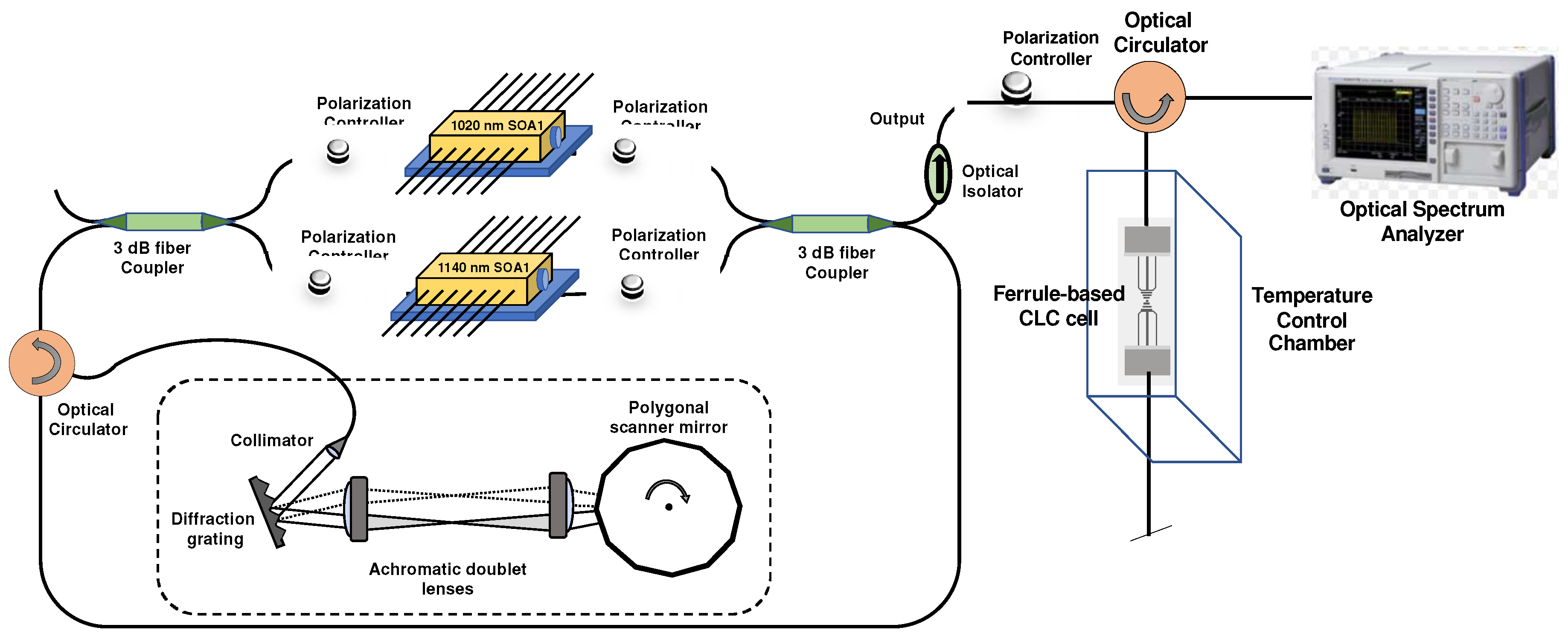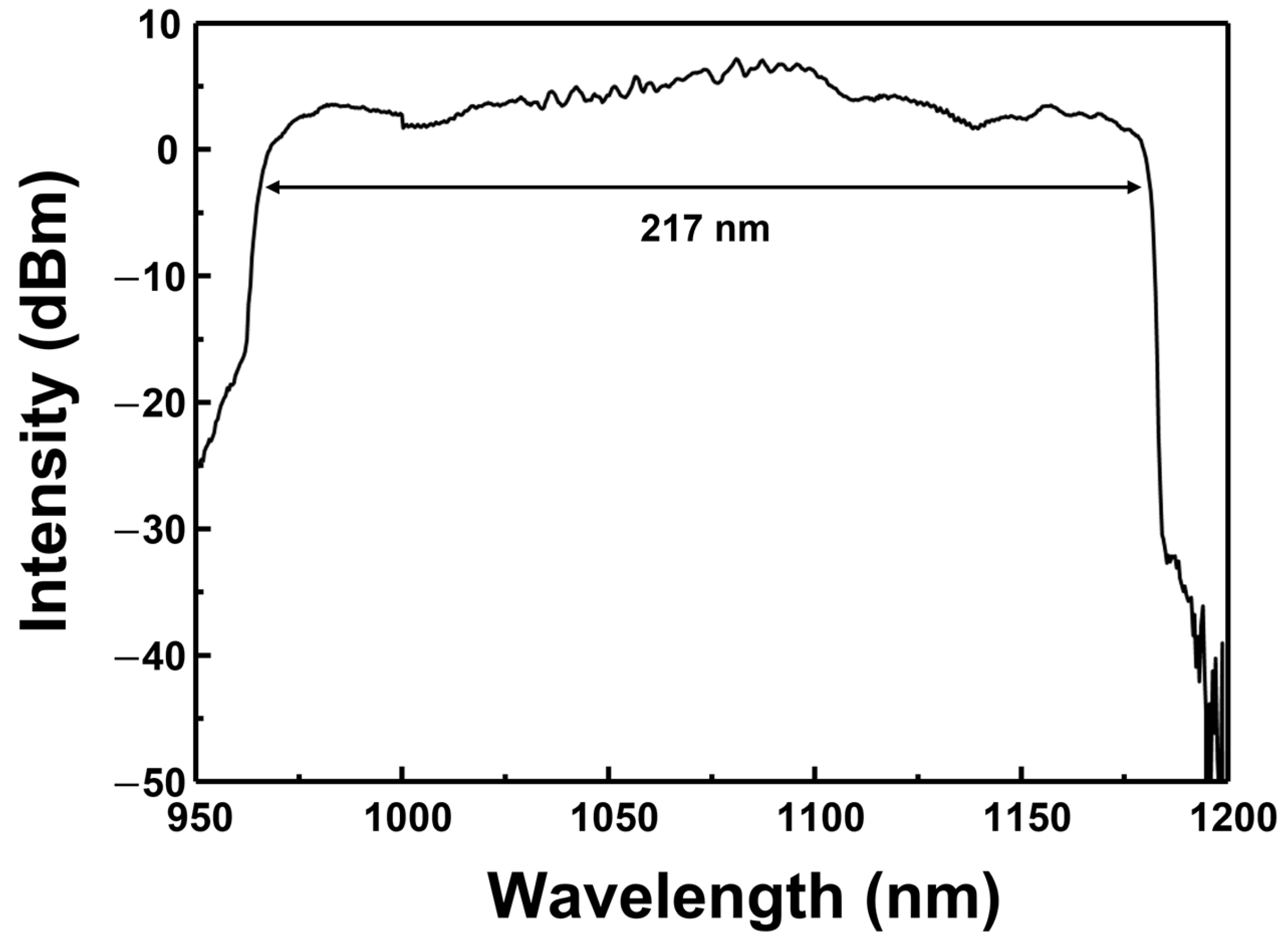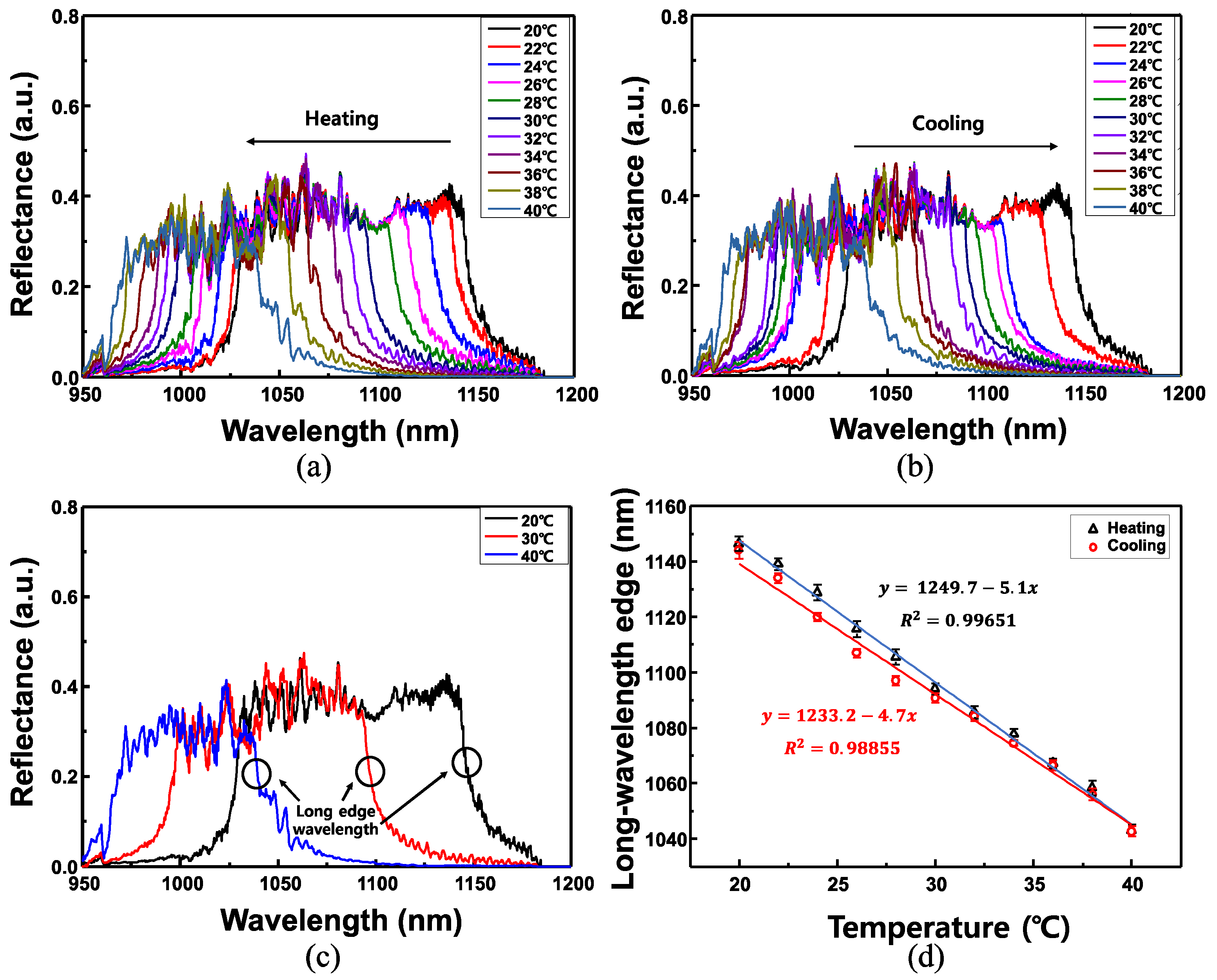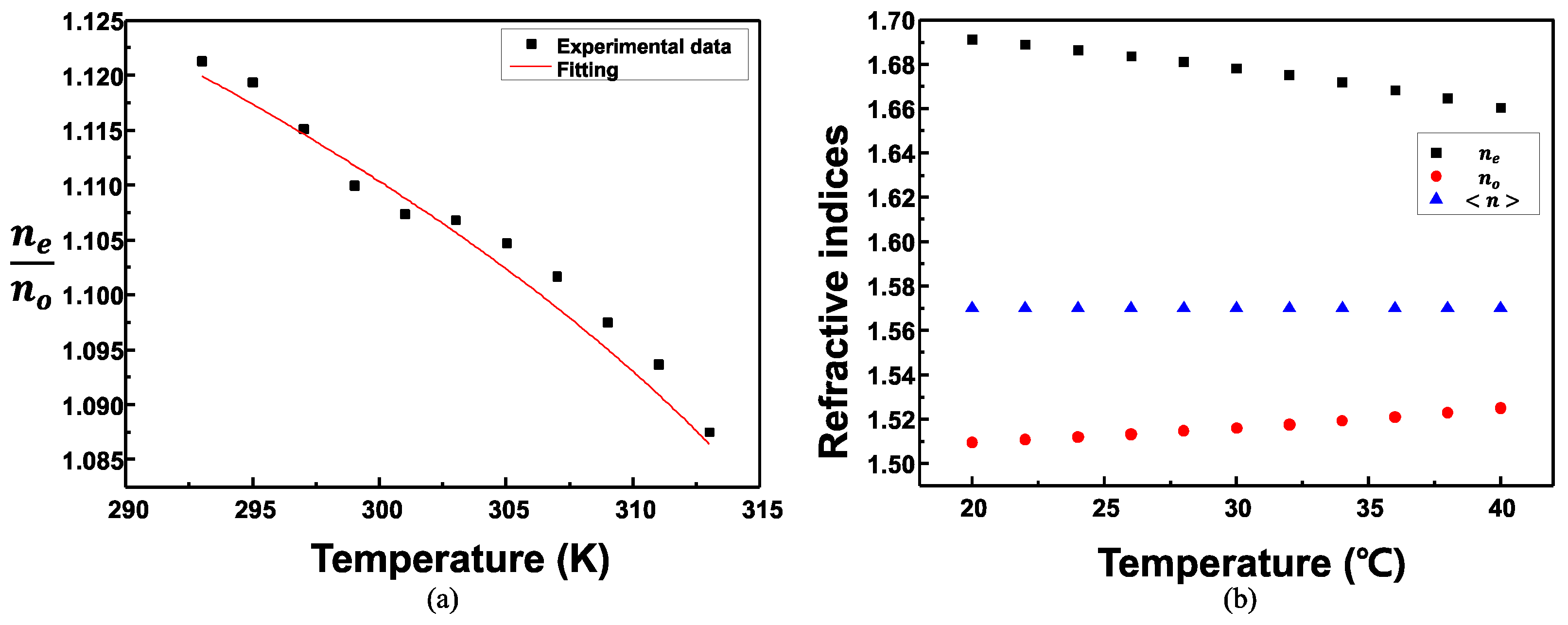Fiber-Optic Temperature Sensor Using Cholesteric Liquid Crystals on the Optical Fiber Ferrules
Abstract
:1. Introduction
2. Fabrication of the CLC Cell
3. Experiments
4. Conclusions
Author Contributions
Funding
Institutional Review Board Statement
Informed Consent Statement
Data Availability Statement
Conflicts of Interest
References
- Pevec, S.; Donlagić, D. Multiparameter fiber-optic sensors: A review. Opt. Eng. 2019, 58, 072009. [Google Scholar] [CrossRef] [Green Version]
- Chu, R.; Guan, C.; Bo, Y.; Shi, J.; Zhu, Z.; Li, P.; Yang, J.; Yuan, L. All-optical graphene-oxide humidity sensor based on a side-polished symmetrical twin-core fiber Michelson interferometer. Sens. Actuators B Chem. 2019, 284, 623–627. [Google Scholar] [CrossRef]
- Wang, Y.; Huang, Q.; Zhu, W.; Yang, M.; Lewis, E. Novel optical fiber SPR temperature sensor based on MMF-PCF-MMF structure and gold-PDMS film. Opt. Express 2018, 26, 1910–1917. [Google Scholar] [CrossRef] [PubMed]
- Roriz, P.; Silva, S.; Frazao, O.; Novais, S. Optical Fiber Temperature Sensors and Their Biomedical Applications. Sensors 2020, 20, 2113. [Google Scholar] [CrossRef] [Green Version]
- Hernandez-Romano, I.; Cruz-Garcia, M.A.; Moreno-Hernandez, C.; Monzon-Hernandez, D.; Lopez-Figueroa, E.O.; Paredes-Gallardo, O.E.; Torres-Cisneros, M.; Villatoro, J. Optical fiber temperature sensor based on a microcavity with polymer overlay. Opt. Express 2016, 24, 5654–5661. [Google Scholar] [CrossRef] [PubMed]
- Zhang, C.; Fu, S.; Tang, M.; Liu, D. Parallel Fabry-Perot interferometers fabricated on multicore-fiber for temperature and strain discriminative sensing. Opt. Express 2020, 28, 3190–3199. [Google Scholar] [CrossRef]
- Huang, Y.; Liu, S.; Zhang, L.; Wang, Y.; Wang, Y. Self-Imaging Effect in Liquid-Filled Hollow-Core Capillary Waveguide for Sensing Applications. Sensors 2019, 20, 135. [Google Scholar] [CrossRef] [PubMed] [Green Version]
- Chunxia, Y.; Hui, D.; Wei, D.; Chaowei, X. Weakly-coupled multicore optical fiber taper-based high-temperature sensor. Sens. Actuators A Phys. 2018, 280, 139–144. [Google Scholar] [CrossRef]
- Wang, S.-N.; Lv, R.-Q.; Zhao, Y.; Qian, J.-K. A Mach-Zehnder interferometer-based High Sensitivity Temperature sensor for human body monitoring. Opt. Fiber Technol. 2018, 45, 93–97. [Google Scholar] [CrossRef]
- Noor, S.F.S.M.; Harun, S.W.; Ahmad, H.; Muhammad, A.R. Multimode interference based fiber-optic sensor for temperature measurement. J. Phys. Conf. Ser. 2019, 1151, 012023. [Google Scholar] [CrossRef]
- Han, Y.; Jiang, Y.; Guo, W. Sensing characteristics of side-polished fiber based on the alterations in helical structure of thermos-senstive cholesteric liquid crystals. Crystals 2019, 9, 465. [Google Scholar] [CrossRef] [Green Version]
- Liu, B.; Luo, J.; Liu, S.; Chen, Y.; Huang, B.; Liao, C.; Wang, Y. A Probe-Shaped Sensor with FBG and Fiber-Tip Bubble for Pressure and Temperature Sensing. Photonic Sens. 2021, 11, 411–417. [Google Scholar] [CrossRef]
- Esteves, C.; Ramou, E.; Porteira, A.R.; Moura Barbosa, A.J.; Roque, A.C. Seeing the Unseen: The Role of Liquid Crystals in Gas-Sensing Technologies. Adv. Opt. Mater. 2020, 8, 1902117. [Google Scholar] [CrossRef] [PubMed]
- Algorri, J.F.; Zografopoulos, D.C.; Urruchi, V.; Sánchez-Pena, J.M. Recent Advances in Adaptive Liquid Crystal Lenses. Crystals 2019, 9, 272. [Google Scholar] [CrossRef] [Green Version]
- Algorri, J.F.; Garcia-Camara, B.; Urruchi, V.; Sanchez-Pena, J.M. High-Sensitivity Fabry-Pérot Temperature Sensor Based on Liquid Crystal Doped with Nanoparticles. IEEE Photonics Technol. Lett. 2015, 27, 292–295. [Google Scholar] [CrossRef]
- Guo, Y.; Li, J.; Li, S.; Liu, Y.; Meng, X.; Bi, W.; Lu, H.; Cheng, T.; Hao, R. Amphibious sensor of temperature and refractive index based on D-shaped photonic crystal fibre filled with liquid crystal. Liq. Cryst. 2020, 47, 882–894. [Google Scholar] [CrossRef]
- Algorri, J.F.; Zografopoulos, D.C.; Tapetado, A.; Poudereux, D.; Sanchez-Pena, J.M. Infiltrated Photonic Crystal Fibers for Sensing Applications. Sensors 2018, 18, 4263. [Google Scholar] [CrossRef] [PubMed] [Green Version]
- Li, J.; Gauza, S.; Wu, S.-T.; Alkeskjold, T.T.; Lægsgaard, J.; Bjarklev, A. High dn o/dT Liquid Crystals and their Applications in a Thermally Tunable Liquid Crystal Photonic Crystal Fiber. Mol. Cryst. Liq. Cryst. 2006, 453, 355–370. [Google Scholar] [CrossRef]
- Algorri, J.F.; Garcia-Camara, B.; Garcia-Garcia, A.; Urruchi, V.; Sanchez-Pena, J.M. Fiber Optic Temperature Sensor Based on Amplitude Modulation of Metallic and Semiconductor Nanoparticles in a Liquid Crystal Mixture. J. Lightwave Technol. 2015, 33, 2451–2455. [Google Scholar] [CrossRef]
- Xianyu, H.; Faris, S.; Crawford, G.P. In-plane switching of cholesteric liquid crystals for visible and near-infrared applications. Appl. Opt. 2004, 43, 5006–5015. [Google Scholar] [CrossRef] [PubMed]
- Mitov, M.; Dessaud, N. Going beyond the reflectance limit of cholesteric liquid crystals. Nat. Mater. 2006, 5, 361–364. [Google Scholar] [CrossRef] [PubMed]
- Zografopoulos, D.C.; Kriezis, E.E.; Mitov, M.; Binet, C. Theoretical and experimental optical studies of cholesteric liquid crystal films with thermally induced pitch gradients. Phys. Rev. E 2006, 73, 061701. [Google Scholar] [CrossRef] [PubMed] [Green Version]
- Ko, M.O.; Kim, S.-J.; Kim, J.-H.; Jeon, M.Y. In situ observation of dynamic pitch jumps of in-planar cholesteric liquid crystal layers based on wavelength-swept laser. Opt. Express 2018, 26, 28751–28762. [Google Scholar] [CrossRef] [PubMed]
- Ahn, S.; Ko, M.O.; Kim, J.-H.; Chen, Z.; Jeon, M.Y. Characterization of second-order reflection bands from a cholesteric liquid crystal cell based on a wavelength-swept laser. Sensors 2020, 20, 4643. [Google Scholar] [CrossRef] [PubMed]
- Lee, G.H.; Ahn, S.; Gene, J.W.; Jeon, M.Y. 1.1-µm Band Extended Wide-Bandwidth Wavelength-Swept Laser Based on Polygonal Scanning Wavelength Filter. Sensors 2021, 21, 3053. [Google Scholar] [CrossRef]
- Hu, J.; Zhou, D.; Su, Y.; Liu, S.; Miao, P.; Shi, Y.; Sun, W.; Liu, Y. Fiber micro-tip temperature sensor based on cholesteric liquid crystal. Opt. Lett. 2020, 45, 5209–5212. [Google Scholar] [CrossRef] [PubMed]
- Ahn, S.; Lee, G.H.; Kim, Y.S.; Yang, J.Y.; Bak, N.-H.; Choi, B.K.; Pagidi, S.; Kim, M.-D.; Kim, J.-H.; Jeon, M.Y. Fiber optic temperature sensor using a fiber ferrule-based cholesteric liquid crystal cell. In Proceedings of the SPIE PC12023, Emerging Liquid Crystal Technologies XVII, San Francisco, CA, USA, 7 March 2022; p. PC120230F. [Google Scholar] [CrossRef]
- Cheng, Z.; Li, K.; Guo, R.; Wang, F.; Wu, X.; Zhang, L.; Xiao, J.; Cao, H.; Yang, Z.; Yang, H. Bandwidth-controllable reflective polarisers based on the temperature-dependent chiral conflict in binary chiral mixtures. Liq. Cryst. 2011, 38, 233–239. [Google Scholar] [CrossRef]
- Shim, K.S.; Heo, J.U.; Jo, S.I.; Lee, Y.J.; Kim, H.R.; Kim, J.H.; Yu, C.J. Temperature-independent pitch invariance in cholesteric liquid crystal. Opt. Express 2014, 22, 15467–15472. [Google Scholar] [CrossRef] [PubMed]
- De Gennes, P.-G.; Prost, J. The Physics of Liquid Crystals, 2nd ed.; Oxford University Press: Oxford, UK, 1993. [Google Scholar]
- Jung, E.J.; Kim, C.-S.; Jeong, M.Y.; Kim, M.K.; Jeon, M.Y.; Jung, W.; Chen, Z. Characterization of FBG sensor interrogation based on a FDML wavelength swept laser. Opt. Express 2008, 16, 16552–16560. [Google Scholar] [CrossRef] [Green Version]
- Jeon, M.Y.; Zhang, J.; Wang, Q.; Chen, Z. High-speed and wide bandwidth Fourier domain mode-locked wavelength swept laser with multiple SOAs. Opt. Express 2008, 16, 2547–2554. [Google Scholar] [CrossRef] [PubMed]
- Park, J.; Kwon, Y.S.; Ko, M.O.; Jeon, M.Y. Dynamic fiber Bragg grating strain sensor interrogation with real-time measurement. Opt. Fiber Technol. 2017, 38, 147–153. [Google Scholar] [CrossRef]
- Lee, H.J.; Kim, S.-J.; Ko, M.O.; Kim, J.-H.; Jeon, M.Y. Tunable, multiwavelength-swept fiber laser based on nematic liquid crystal device for fiber-optic electric-field sensor. Opt. Commun. 2018, 410, 637–642. [Google Scholar] [CrossRef]
- Choi, B.K.; Ahn, S.; Kim, J.S.; Pagidi, S.; Jeon, M.Y. Output Stabilization of Wavelength-Swept Laser Based on Closed-Loop Control of Fabry-Perot Tunable Wavelength Filter for Fiber-Optic Sensors. Sensors 2022, 22, 4337. [Google Scholar] [CrossRef] [PubMed]
- Dixon, G.D.; Scala, L.C. Thermal hysteresis in cholesteric color responses. Mol. Cryst. Liq. Cryst. 1970, 10, 317–325. [Google Scholar] [CrossRef]
- Li, J.; Gauzia, S.; Wu, S.-T. Temperature effect on liquid crystal refractive indices. J. Appl. Phys. 2004, 96, 19. [Google Scholar] [CrossRef]
- Li, J.; Wu, S.-T. Infrared refractive indices of liquid crystals. J. Appl. Phys. 2005, 97, 073501. [Google Scholar] [CrossRef]
- Li, J.; Gauzia, S.; Wu, S.-T. High temperature-gradient refractive index liquid crystals. Opt. Express 2004, 12, 2002–2020. [Google Scholar] [CrossRef] [PubMed] [Green Version]









| Authors | Year | Method | Sensitivity | Detection Range |
|---|---|---|---|---|
| Chunxia et al. [8] | 2018 | tapered multi-core fiber | 36.8 pm/°C | 20~1000 °C |
| Wang et al. [9] | 2018 | Mach–Zehnder interferometer | 8.962 nm/°C | 33~43 °C |
| Noor et al. [10] | 2019 | multi-mode interference | 21 pm/°C | - |
| Han et al. [11] | 2019 | CLC film based on a side polished fiber | 1.7 nm/°C | °C |
| Hu et al. [26] | 2020 | dye-doped CLC-based on a fiber micro tip | −9.167 nm/°C | 23~29 °C |
| Liu et al. [12] | 2021 | FBG and fiber-tip bubble | 11.1 pm/°C | 20~100 °C |
| Our work | 2022 | Optical fiber ferrule-based CLC cell | −5.0 nm/°C | 20~40 °C |
| A | B | ||
|---|---|---|---|
| 1.5072 | 6.4173 × 10−8 | 0.3747 | 0.3159 |
Publisher’s Note: MDPI stays neutral with regard to jurisdictional claims in published maps and institutional affiliations. |
© 2022 by the authors. Licensee MDPI, Basel, Switzerland. This article is an open access article distributed under the terms and conditions of the Creative Commons Attribution (CC BY) license (https://creativecommons.org/licenses/by/4.0/).
Share and Cite
Ahn, S.; Lee, G.H.; Lee, J.-Y.; Kim, Y.; Kim, M.S.; Pagidi, S.; Choi, B.K.; Kim, J.S.; Kim, J.-H.; Jeon, M.Y. Fiber-Optic Temperature Sensor Using Cholesteric Liquid Crystals on the Optical Fiber Ferrules. Sensors 2022, 22, 5752. https://doi.org/10.3390/s22155752
Ahn S, Lee GH, Lee J-Y, Kim Y, Kim MS, Pagidi S, Choi BK, Kim JS, Kim J-H, Jeon MY. Fiber-Optic Temperature Sensor Using Cholesteric Liquid Crystals on the Optical Fiber Ferrules. Sensors. 2022; 22(15):5752. https://doi.org/10.3390/s22155752
Chicago/Turabian StyleAhn, Soyeon, Gi Hyen Lee, Jun-Yong Lee, Youngseo Kim, Min Su Kim, Srinivas Pagidi, Byeong Kwon Choi, Ji Su Kim, Jong-Hyun Kim, and Min Yong Jeon. 2022. "Fiber-Optic Temperature Sensor Using Cholesteric Liquid Crystals on the Optical Fiber Ferrules" Sensors 22, no. 15: 5752. https://doi.org/10.3390/s22155752
APA StyleAhn, S., Lee, G. H., Lee, J.-Y., Kim, Y., Kim, M. S., Pagidi, S., Choi, B. K., Kim, J. S., Kim, J.-H., & Jeon, M. Y. (2022). Fiber-Optic Temperature Sensor Using Cholesteric Liquid Crystals on the Optical Fiber Ferrules. Sensors, 22(15), 5752. https://doi.org/10.3390/s22155752







